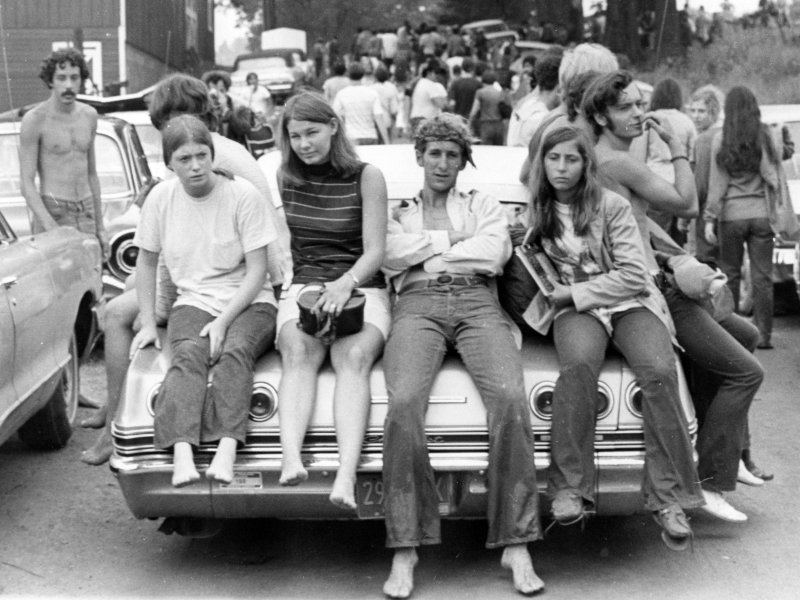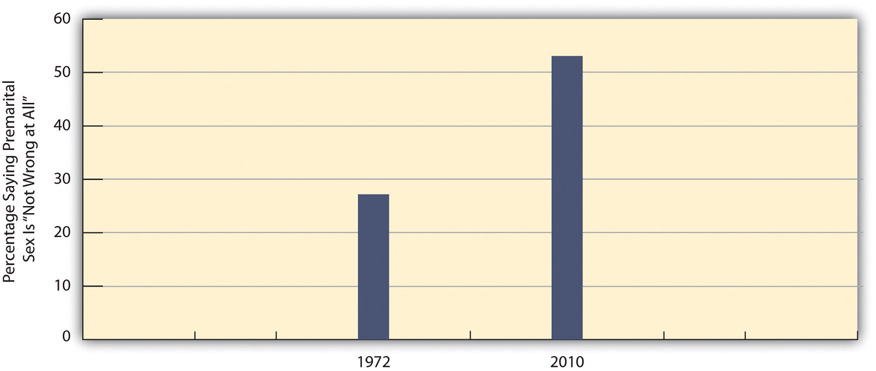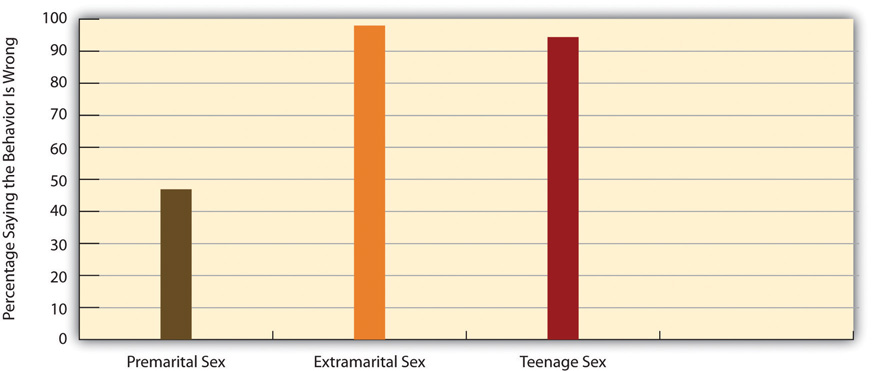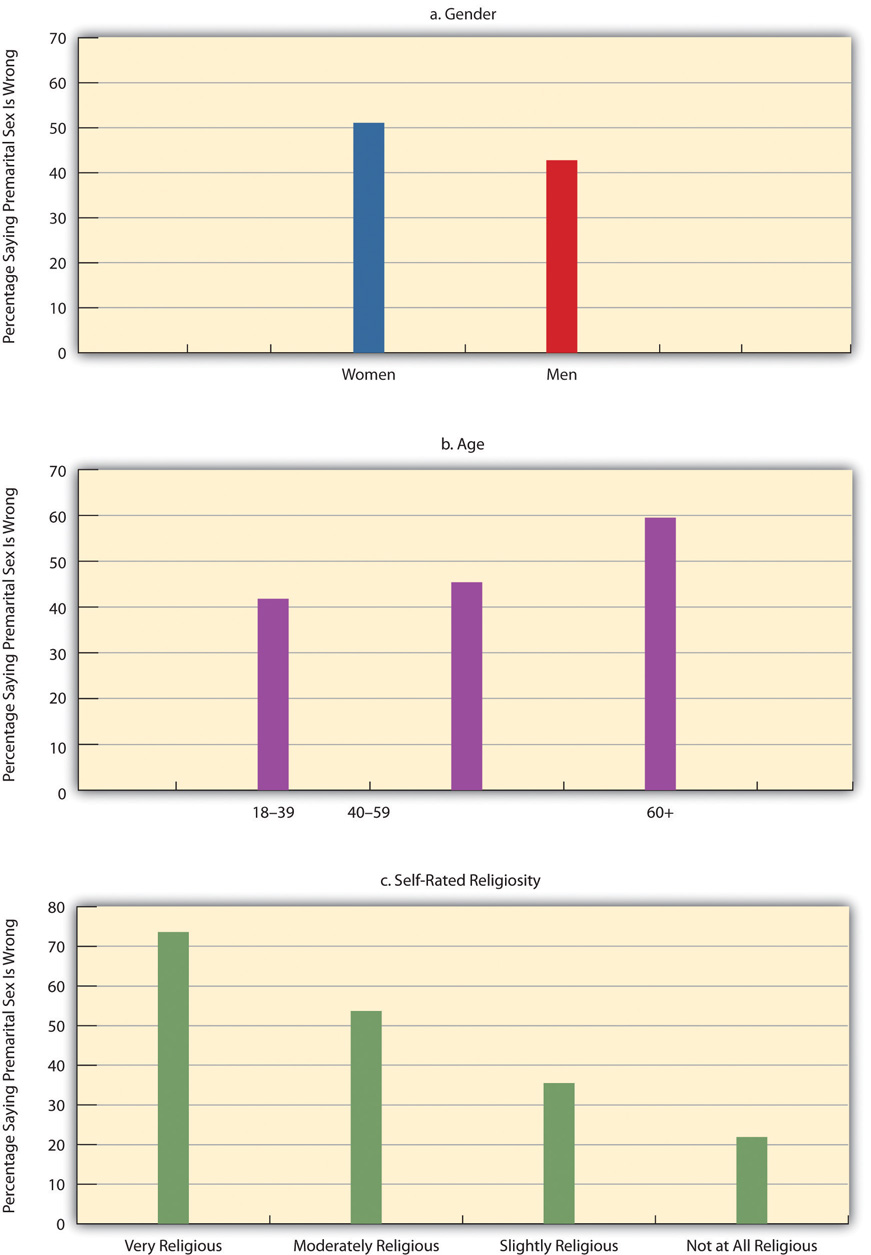54 9.1 An Overview of Heterosexuality
Learning Objectives
- Explain what happened as a result of the sexual revolution.
- Describe current views on sexual behavior.
- Understand the prevalence of certain sexual behaviors today.
Because Chapter 5 “Sexual Orientation and Inequality” discussed sexual orientation and inequality, this chapter’s discussion of sexual behavior focuses almost entirely on issues concerning heterosexual sex. To provide a backdrop for these issues, we first provide an overview of heterosexual behavior and views about such behavior.
The Sexual Revolution: Changing Attitudes and Changing Behavior

The youth counterculture of the 1960s emphasized that sexual intercourse need not be delayed until marriage. Their views helped fuel the so-called sexual revolution.
Wikimedia Commons – CC BY 3.0.
The 1960s were a time of major change in the United States. The Southern civil rights movement and Vietnam antiwar movements shook the nation, and the women’s rights, gay rights, and environmental movements began. Another major change was the sexual revolution, which saw a substantial change in many aspects of Americans’ sexual behavior and in how they thought about sex. Thanks in large part to the introduction of the birth control pill, women became freer to have sex without fear of pregnancy. The hippies of the youth counterculture of the 1960s emphasized free love, the idea that sexual intercourse and other forms of sex need not be delayed until marriage, and a popular slogan heard during the Vietnam antiwar movement was “make love, not war.” A highlight (or lowlight, depending on one’s view) of the era was the Summer of Love in 1967, when tens of thousands of young people gathered in the Haight-Ashbury neighborhood of San Francisco to do drugs, have sex, and engage in other counterculture activities. The appearance of HIV and AIDS during the 1980s reversed some of the trends of the sexual revolution, as people became more concerned about the consequences of unprotected sex, but the effects of this revolution largely remain: Many more people now have sex before marriage than before the 1960s, and views about certain sexual behaviors have become less conservative since the 1960s and 1970s (Harding & Jencks, 2003).
We can see evidence of changing views about sex in data from the General Social Survey (GSS), which has been administered nationally since the early 1970s. One of the questions the GSS asks is about premarital sex: “There’s been a lot of discussion about the way morals and attitudes about sex are changing in this country. If a man and woman have sex relations before marriage, do you think it is always wrong, almost always wrong, wrong only sometimes, or not wrong at all?” In 1972, only 27.2 percent of the public replied it was “not wrong at all,” but by 2010, this percentage almost doubled to 53.1 percent (see Figure 9.1 “Change in Views about Premarital Sex (Percentage Saying Premarital Sex Is “Not Wrong at All”)”).
Figure 9.1 Change in Views about Premarital Sex (Percentage Saying Premarital Sex Is “Not Wrong at All”)
Source: Data from General Social Surveys. (1972 and 2010). Retrieved from http://sda.berkeley.edu/cgi-bin/hsda?harcsda+gss10.
On two other issues, extramarital sex and sex between teenagers, views have not changed from a generation ago. Very few Americans today, fewer than 5 percent, think that either type of sexual behavior is “not wrong at all,” and very few thought they were not wrong a generation ago when the GSS asked about these two behaviors. As all these trend data indicate, the sexual revolution changed certain sexual attitudes but did not affect other attitudes. In this respect, then, the sexual revolution was only partly revolutionary.
Certain changes in sexual behavior also occurred as part of the sexual revolution. In particular, many more people began having sex before age 18 during and after the 1960s than before the 1960s and, in a related trend, to have more sexual partners before age 18 (Laumann, Gagnon, Michael, & Michaels, 1994). We can see evidence of the former trend in national survey data reported in Table 9.1 “Percentage Who Had Heterosexual Sex before Age 18”, which shows the percentage of people born in different decades (birth cohorts) who had sex before age 18. Among women, less than one-third of those in the 1933–1942 and 1943–1952 birth cohorts (who would all have reached age 18 before the sexual revolution) had sex before age 18. These low figures jumped to 47.6 percent for those in the 1953–1962 birth cohort (who became teenagers in the 1960s and 1970s, during the sexual revolution) and then grew further to 58.2 percent in the next birth cohort. In a twenty-year span, then, women became 28.2 percent more likely (= 58.2 – 30.0) to have sex before age 18. Men, too, became more likely to have sex before age 18, though at a slightly smaller rate of increase, 18.8 percent (= 61.3 – 42.5) over the thirty-year span shown in the table. In related figures, only 30 percent of teenaged girls in 1972 were sexually experienced; by 1988, this figure had jumped to 51 percent (Martinez, Copen, & Abma, 2011). The remarkable increase in teenage sex for both females and males since the 1960s has had important repercussions down to the present, as we shall see in the section on teenage sex and pregnancy later in this chapter.
Table 9.1 Percentage Who Had Heterosexual Sex before Age 18
| Birth cohort | 1933–1942 | 1943–1952 | 1953–1962 | 1963–1974 |
|---|---|---|---|---|
| Women | 32.2 | 30.0 | 47.6 | 58.2 |
| Men | 42.5 | 47.9 | 56.8 | 61.3 |
Source: Laumann, E. O., Gagnon, J. H., Michael, R. T., & Michaels, S. (1994). The social organization of sexuality. (p. 328) Chicago, IL: University of Chicago Press.
Heterosexuality Today: Attitudes and Behavior
Americans’ attitudes today about heterosexual behavior are very diverse. On some issues, Americans are fairly united, either in a more tolerant and accepting direction or in a less tolerant and unaccepting direction. On other issues, Americans are fairly divided, with large numbers of people feeling one way and large numbers feeling another way. The American public is probably even more diverse in its sexual behavior: Some people have a lot of sex and engage in a variety of sexual activities, while other people have less sex and limit their sexual activity to vaginal intercourse. To gain a sense of what Americans are thinking and doing in the area of heterosexual activity, national surveys provide some important evidence.
Attitudes
As noted earlier, the GSS asks respondents to indicate their views on several types of heterosexual behavior and issues related to this behavior. We’ll first look again at their views about sexual behavior that we examined earlier in the discussion about the sexual revolution. This time we will focus on the percentage who say the behaviors are wrong (“always wrong,” “almost always wrong,” or “sometimes wrong”) (see Figure 9.2 “Views on Sexual Behavior (Percentage Saying the Behavior Is Wrong)”).
Figure 9.2 Views on Sexual Behavior (Percentage Saying the Behavior Is Wrong)
Source: Data from General Social Survey. (2010). Retrieved from http://sda.berkeley.edu/cgi-bin/hsda?harcsda+gss10.
Figure 9.2 “Views on Sexual Behavior (Percentage Saying the Behavior Is Wrong)” shows that Americans almost unanimously think that adultery (extramarital sex) and teenage sex are wrong, but that they are fairly evenly split on whether premarital sex is wrong, with 47 percent saying it is wrong and the remainder, 53 percent, saying it is not wrong at all.
Certain aspects of our social backgrounds predict our views about premarital sex. In particular, women, older people, and those who are more religious are more likely than their counterparts to disapprove of it. We see evidence of these trends in Figure 9.3 “Correlates of Disapproval of Premarital Sex (Percentage Saying Premarital Sex between a Woman and a Man Is Wrong)”, which focuses on the percentage of GSS respondents who say that premarital sex is wrong (always wrong, almost always wrong, or sometimes wrong). Gender and age are moderately related to views about premarital sex, while religiosity is strongly related to these views.
Figure 9.3 Correlates of Disapproval of Premarital Sex (Percentage Saying Premarital Sex between a Woman and a Man Is Wrong)
Source: Data from General Social Survey. (2010). Retrieved from http://sda.berkeley.edu/cgi-bin/hsda?harcsda+gss10.
Behavior
A good understanding of Americans’ sexual behaviors comes from the 2006–2008 National Survey of Family Growth (NSFG), which was administered to 13,459 Americans ages 15–44 nationwide. Although this survey omits people older than 44, it still yields valuable information about people in their prime reproductive years. Chapter 5 “Sexual Orientation and Inequality” on sexual orientation also used some NSFG data.
Table 9.2 “Lifetime Prevalence of Sexual Behaviors, Ages 15–24*” reports some NSFG gender-based data on several kinds of sexual behaviors for young people ages 15–24. Although many people think that males are much more sexually active than females, the data in Table 9.2 “Lifetime Prevalence of Sexual Behaviors, Ages 15–24*” show that the gender differences in heterosexual contact are practically nonexistent. Reflecting a conclusion from Chapter 5 “Sexual Orientation and Inequality”’s discussion of sexual orientation, however, females are more likely than males to have had same-sex sexual contact. In one other gender difference not reported in the table, males (17.6 percent) are more likely than females (9.4 percent) to have at least two heterosexual partners in the past year. In this specific sexual activity, then, males are indeed more active than females.
Table 9.2 Lifetime Prevalence of Sexual Behaviors, Ages 15–24*
| Females | Males | |
|---|---|---|
| No sexual contact | 28.6 | 27.2 |
| Any opposite-sex contact | 70.1 | 71.7 |
| Any opposite-sex contact: vaginal intercourse | 65.1 | 62.9 |
| Any opposite-sex contact: gave or received oral sex | 62.6 | 64.0 |
| Any opposite-sex contact: anal sex | 20.2 | 20.9 |
| Any same-sex behavior | 13.4 | 4.0 |
| * Percentage engaging in behavior at least once | ||
Source: Chandra, A., Mosher, W. D., Copen, C., & Sionean, C. (2011). Sexual behavior, sexual attraction, and sexual identity in the United States: Data from the 2006–2008 national survey of family growth (National Health Statistics Reports: Number 36). Hyattsville, MD: National Center for Health Statistics.

Although women and men in the United States are equally sexually active, unmarried men tend to have more sexual partners than unmarried women.
Steve C Et tant pis pour les jaloux ! – CC BY 2.0.
We saw earlier that higher degrees of religiosity are strongly associated with greater disapproval of premarital sex. Does this mean that religiosity should also be associated with a lower likelihood of actually engaging in premarital sex? The answer is clearly yes, as many studies of adolescents find that those who are more religious are more likely to still be virgins and, if they have had sex, more likely to have had fewer sexual partners (Regenerus, 2007). Survey data on adults yield a similar finding: Among all never-married adults in the GSS, those who are more religious are also more likely to have had fewer sexual partners (Barkan, 2006). We see evidence of this relationship in Table 9.3 “Self-Rated Religiosity and Number of Sexual Partners in Past Five Years among Never-Married Adults Ages 18–39 (%)”, which shows that among never-married adults ages 18–39, those who are very religious are more likely to have had no sexual partners in the past five years and, if they have had any partners, to have had fewer partners. Although it is hypothetically possible that not having sexual partners leads someone to become more religious, it is much more likely that being very religious reduces the number of sexual partners that never-married adults have.
Table 9.3 Self-Rated Religiosity and Number of Sexual Partners in Past Five Years among Never-Married Adults Ages 18–39 (%)
| Number of sexual partners | Very religious | Moderately religious | Slightly religious or not at all religious |
|---|---|---|---|
| 0 | 31.1 | 7.6 | 9.2 |
| 1 | 29.5 | 29.6 | 21.6 |
| 2 or more | 39.4 | 62.8 | 69.2 |
Source: Data from General Social Surveys. (2006–2010). Retrieved from http://sda.berkeley.edu/cgi-bin/hsda?harcsda+gss10.
Key Takeaways
- The sexual revolution liberalized some views about sexual behavior and increased participation in some forms of sexual behavior, particularly premarital sex.
- Gender, age, and religiosity predict attitudes about premarital sex.
- There are little or no gender differences today in the prevalence of various heterosexual behaviors, but men are more likely than women to have had at least two sex partners in the past year.
For Your Review
- Do you think the sexual revolution was a good thing or a bad thing? Explain your answer.
- Did it surprise you to learn that women and men are equally sexually active today? Why or why not?
References
Barkan, S. E. (2006). Religiosity and premarital sex during adulthood. Journal for the Scientific Study of Religion, 45, 407–417.
Harding, D. J., & Jencks, C. (2003). Changing attitudes toward premarital sex. Public Opinion Quarterly, 67(2), 211–226.
Laumann, E. O., Gagnon, J. H., Michael, R. T., & Michaels, S. (1994). The social organization of sexuality. Chicago, IL: University of Chicago Press.
Martinez, G., Copen, C. E., & Abma, J. C. (2011). Teenagers in the United States: Sexual activity, contraceptive use, and childbearing, 2006–2010 national survey of family growth. Vital and Health Statistics, 23(31), 1–35.
Regenerus, M. D. (2007). Forbidden fruit: Sex & religion in the lives of American teenagers. New York, NY: Oxford Univeristy Press.




